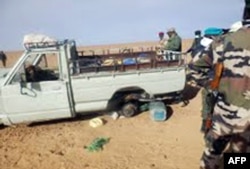The bodies of 18 West African migrants hoping to reach Europe have been found in the Sahara desert near Arlit in Niger, the International Organization for Migration said on Sunday.
The discovery of the group offers a rare glimpse of what migration experts say is a hidden tragedy in the Sahara. Many thousands are attempting to cross the vast and inhospitable terrain in order to reach the Libyan coast, where they hope to begin another hazardous trip by boat to Europe.
"This case is indicative of the difficulties of these journeys, even before reaching the boats in Libya," Giuseppe Loprete, the head of IOM in Niger, said in emailed comments.
"We have to ask ourselves how many people have died [are dying] in the desert even before making it to the Mediterranean," he said. "We don't think this is an isolated case but without a systematic collection of information or without a 'rescue' operation we will never know how many migrants could be possibly missing."
The flow of migrants in the Mediterranean is documented by multiple parties, from coast guards and navies to local authorities and aid organizations. The IOM has said increasing numbers of west Africans have taken the trip this year, although the most common nationalities are still Syrians and Eritreans.
Loprete said patrolling the desert to try to prevent such deaths was "nearly impossible."
The 17 men and one woman found dead were from at least eight countries including Mali, Senegal, Ivory Coast and Guinea. They were travelling in a land cruiser but lost their way in a sandstorm before running out of fuel and getting stuck in the sand.
One, an Algerian, captured a camel and tried to get to the town of Assamaka, which is close to Niger's border with Algeria, to get water and help. But he fell off and died. The others died of dehydration on about June 3 and were found 8 days later, IOM said, citing its staff in Niger and local authorities.
The group had been on the way from Arlit to Assamaka. If they had wanted to reach Tripoli, the capital of Libya, they would still have faced a journey of 2,340 km (1,500 miles) by the shortest road route.











